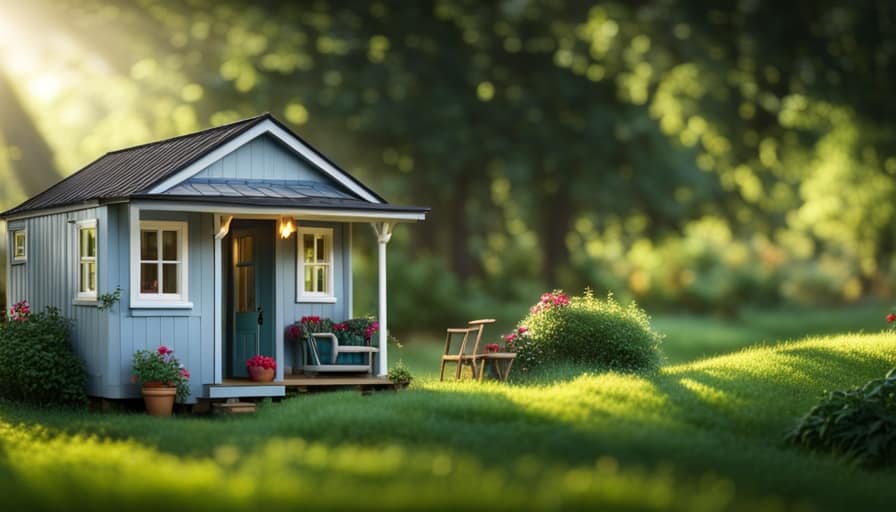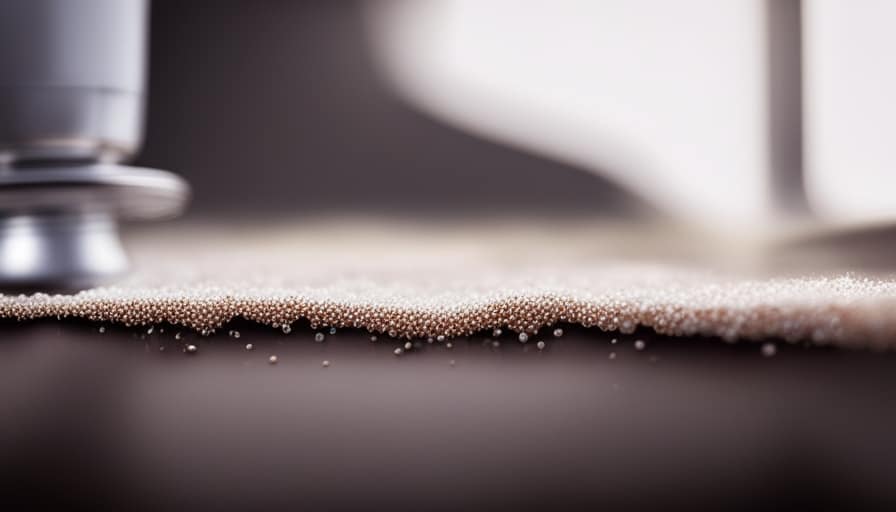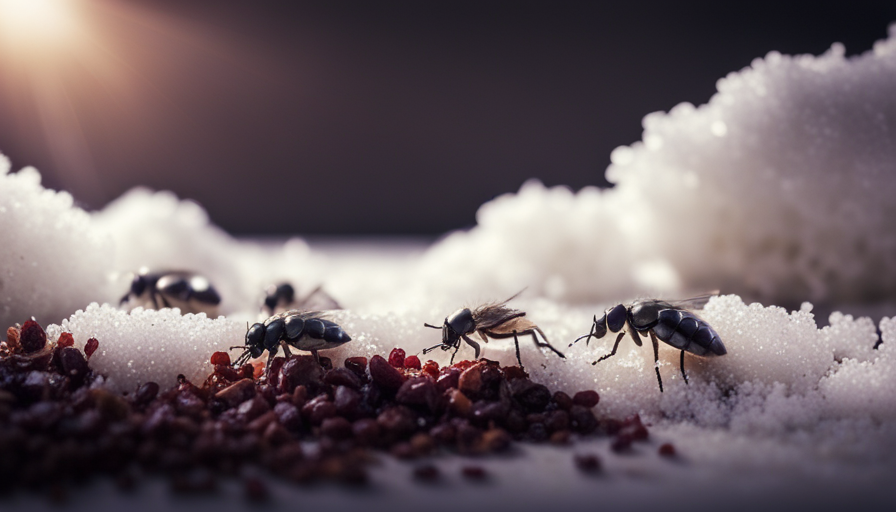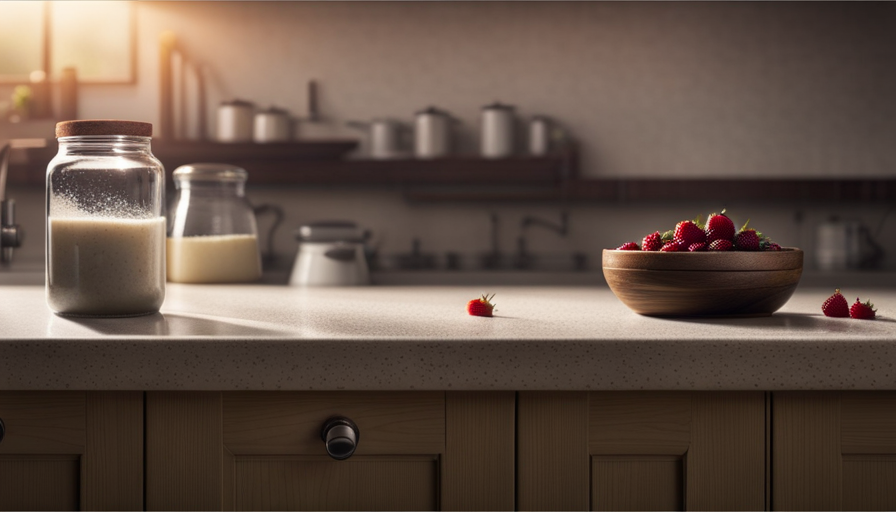I understand the frustration that comes with finding small white bugs in your indoor plants. Not only are they unattractive, but they can also harm your cherished plants.
But fear not! In this article, I will provide you with valuable information on how to identify these pests, the harm they can cause, and effective natural and chemical remedies to get rid of them.
Say goodbye to those pesky white insects and hello to a healthy, thriving house plant!
Key Takeaways
- Mealybugs are common house plant pests that are small, soft-bodied insects covered in a white, waxy substance.
- These insects can be found on the leaves, stems, and roots of plants, and can cause stunted growth, yellowing leaves, honeydew production, and leaf drop if left untreated.
- Natural remedies such as DIY insecticidal soap, essential oils like neem oil, and preventive measures can be effective in getting rid of these white insects without harmful chemicals.
- Chemical insecticides can provide fast and effective results, but it’s important to weigh the pros and cons of chemical vs. organic options and consider potential risks to human health and the environment.
Identifying the Tiny White Insects in Your House Plant
As I inspect my house plant, I’m able to identify the tiny white insects that have infested it. These common house plant pests are known as mealybugs. Mealybugs are small, soft-bodied insects that are covered in a white, waxy substance. They can be found on the leaves, stems, and even the roots of your plants.

While they may seem harmless, mealybugs can cause significant damage to your house plants if left untreated. However, it’s important to note that not all white insects are harmful. Some beneficial insects, like whiteflies, can also appear white in color. Understanding the difference between these insects is crucial in determining the best course of action to protect your plants.
Now, let’s delve into understanding the damage caused by the white insects.
Understanding the Damage Caused by the White Insects
I can observe the damage caused by the white insects in my house plant. These tiny white insects, commonly known as mealybugs, scale insects, or whiteflies, can wreak havoc on your beloved plants.
Here are some signs of damage caused by these pests:

- Stunted growth: Infested plants may show a lack of growth or fail to reach their full potential.
- Yellowing leaves: White insects extract sap from the leaves, causing them to turn yellow and eventually drop off.
- Honeydew and sooty mold: These insects produce a sticky substance called honeydew, which attracts sooty mold, resulting in black, powdery growth on the leaves.
Understanding the damage caused by these white insects is crucial in effectively combating them.
Now, let’s explore natural remedies to get rid of these tiny pests and restore the health of your house plants.
Natural Remedies to Get Rid of the Tiny White Insects
To effectively eliminate the tiny white insects in my house plant, I can use natural remedies and a combination of preventive measures. One effective natural remedy is a DIY insecticidal soap recipe. To make this soap, I can mix one teaspoon of liquid dish soap with one liter of water. I can then spray this mixture onto the affected areas of my plant, making sure to cover both the upper and lower surfaces of the leaves.
Another natural option is to use essential oils for pest control. Essential oils like neem oil, peppermint oil, and lavender oil have insect-repellent properties. I can dilute a few drops of these oils in water and spray it on my plants.

By using these natural remedies, I can effectively get rid of the tiny white insects in my house plant without resorting to harmful chemicals.
Transition: While natural remedies are effective, there are also chemical options available for removing the white insects.
Chemical Options for Removing the White Insects
One option for removing the white insects in my house plant is to use a chemical insecticide. While natural remedies are a popular choice for many, chemical options can provide effective and fast results. Here are some key points to consider when using chemical insecticides:
-
Chemical vs. organic options: Chemical insecticides contain synthetic compounds that are specifically designed to kill pests, while organic options use natural ingredients. It’s important to weigh the pros and cons of each approach before making a decision.

-
Potential risks of using chemicals: Chemical insecticides may pose risks to human health and the environment. It’s crucial to carefully follow the instructions provided by the manufacturer to minimize these risks and ensure safe usage.
Preventing the Return of White Insects in Your House Plant
To keep white insects from coming back to my house plant, it’s important to regularly inspect and clean the leaves and soil. By doing so, you can prevent reinfestation and ensure the health of your plant.
Inspect the leaves regularly for any signs of white insects, such as tiny crawling creatures or white powdery residue. If you spot any, remove them immediately using a soft cloth or brush.
Additionally, check the soil for any signs of infestation, such as eggs or larvae. If you find any, replace the soil and thoroughly clean the pot before repotting the plant.

It’s also important to maintain a clean and healthy environment for your house plant by avoiding overwatering, providing adequate sunlight, and regularly fertilizing as needed.
Frequently Asked Questions
How Do I Know if the Tiny White Insects in My House Plant Are Harmful to My Plant?
To identify common pests in house plants, look for tiny white insects on your plant. To determine if they’re harmful, observe if they cause damage, such as wilting or yellowing leaves. Effective natural remedies include neem oil or a mixture of water and dish soap.
Can the White Insects in My House Plant Cause Any Harm to Humans or Pets?
The tiny white insects in my house plant can cause harm to humans or pets if ingested or come into contact with sensitive skin. I will explain how to get rid of them effectively.
Are the Natural Remedies Mentioned Safe to Use on All Types of House Plants?
Using natural remedies on house plants may have potential risks. Alternatives to getting rid of white insects include introducing natural predators, using insecticidal soaps, or isolating the infested plant.

Can I Use Chemical Options to Get Rid of the White Insects if I Have Young Children or Pets in the House?
I can use chemical-free alternatives and non-toxic pest control methods to get rid of the white insects in my house plant, even if I have young children or pets in the house.
Is There a Way to Prevent the White Insects From Infesting Other House Plants in My Home?
To prevent white insects from infesting other house plants, it’s important to take preventive measures. Regularly inspect plants for signs of infestation and isolate affected plants. Effective natural remedies, like neem oil or insecticidal soap, can also be used.
Conclusion
In conclusion, by identifying and understanding the damage caused by the tiny white insects in your house plant, you can effectively choose from natural remedies or chemical options to get rid of them.
Taking preventative measures will also help in preventing their return.

Just like a skilled exterminator eliminates pests from your home, you can successfully eradicate these pests from your house plant, ensuring its health and growth.
I’m Theodore, and I love tiny houses. In fact, I’m the author of Tiny House 43, a book about tiny houses that are also tree houses. I think they’re magical places where imaginations can run wild and adventures are just waiting to happen.
While tree houses are often associated with childhood, they can be the perfect adult retreat. They offer a cozy space to relax and unwind, surrounded by nature. And since they’re typically built on stilts or raised platforms, they offer stunning views that traditional homes simply can’t match.
If you’re looking for a unique and romantic getaway, a tree house tiny house might just be the perfect option.










